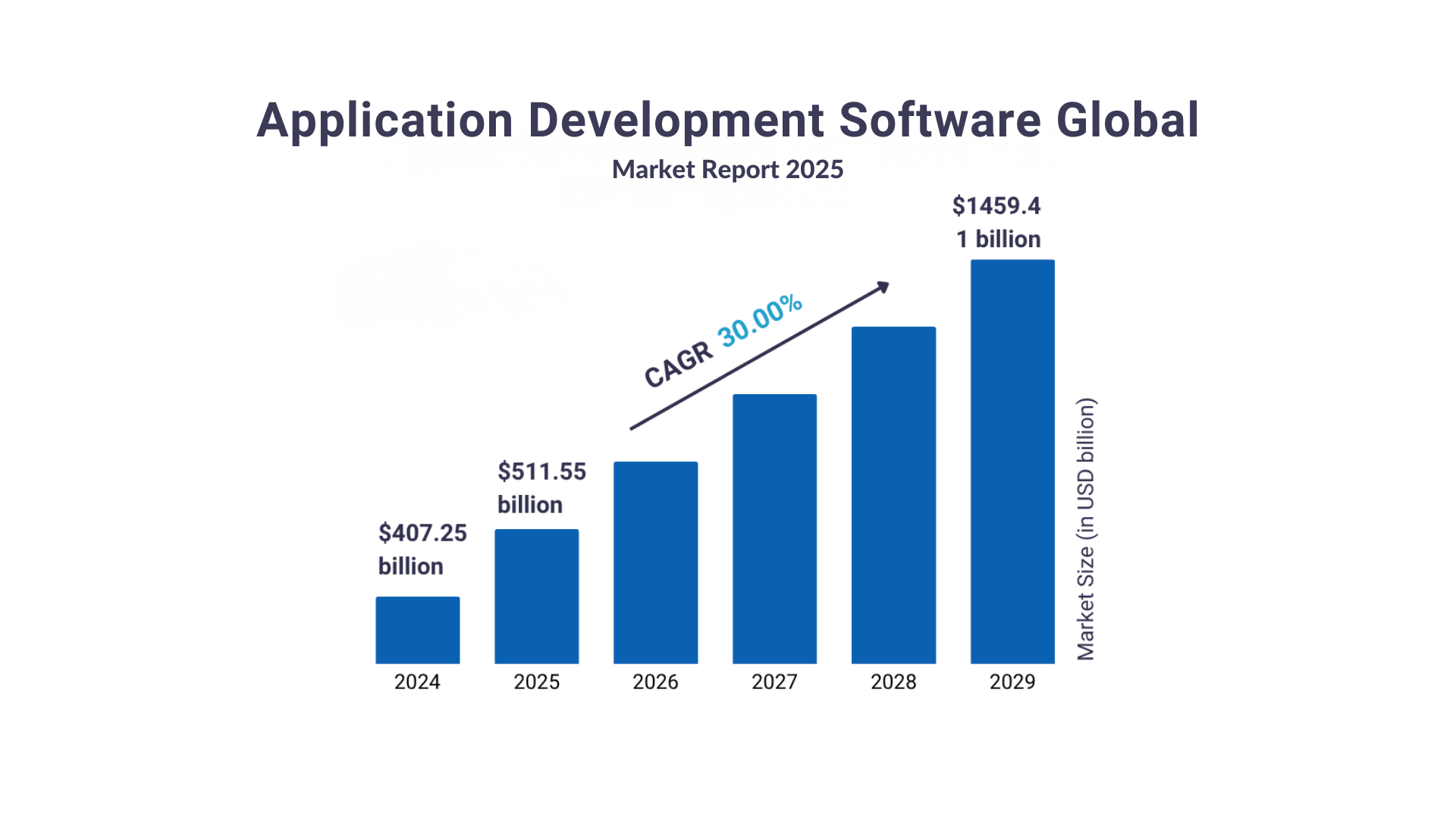Introduction
You Have a Great App Idea… Now What?
Such an idea is the kind of one that could change the way things are, fix a problem that is real, and maybe even become the next big thing.
It’s easy to see why mobile apps help startups connect with customers, build trust, and grow faster than ever before.
But here is a reality check: the mobile app development landscape is more crowded and competitive than ever.
As a matter of fact, the application development software market is on fire, and it is forecasted to increase from $407.25 billion in 2024 to $511.55 billion in 2025.
That is an enormous 25.6% increase in just one year!

So, what is it that this is telling you? It means your vision is in a booming industry, but it also means the path is littered with the ghosts of good ideas that failed to launch correctly.
Many of these failures stem from common app development mistakes startups make right from the beginning.
The good news? These pitfalls are almost always avoidable. You don’t need to be a tech expert to steer clear of the most costly startups app development mistakes. You just need a little guidance.
So let’s walk you through the top 5 startup mistakes in the app world.

Our goal is to help you avoid startup mistakes that cost you more and crush your morale, so you can build an app that users love and that truly succeeds.
Let’s get started.
Why Do Startups Struggle with App Development? (It’s Not Just You!)

The idea of creating a mobile app is fascinating, and it really is! But for a great number of new businesses, the way from concept to release is not as effortless as it seems.
The majority of startup app development mistakes occur due to the fact that founders are new to the process, and they fail to see that it requires a lot of planning.
It is typical, when you are just starting up to think, “Let’s get the app done first and solve the rest later.”
However, this is probably the worst thing that a startup can do in its app development.
A lack of plan, research, and the right team leads to situations where minor mistakes quickly escalate into the costly startups ones.
Reason number two is speed. Startups are usually eager to go fast in order to attract investors or be the first on the market with a new feature; however, what is rushing good for if it results in poor design, bugs, or apps that users don’t really need?
The optimum strategy for evading the startup errors is to decelerate just enough in order to carry out a proper planning session.
If you get to know the obstacles that are usually there when you start, then you will be in position to make better decisions, save more money, and make an app that really connects with your audience.
Let’s start with the 5 major mistakes startups make when developing an app. Also, find out how you can keep a step ahead of them.
Looking for your next big startup? Check out our Top 40 Billion Dollar App Ideas that Make You A Billionaire for inspiration.
Mistake #1: Skipping Market Research
One of the biggest app development mistakes startups make is jumping straight into coding without doing proper market research.
Many entrepreneurs get excited about their idea, which is great, but they forget to check if people actually need or want their app.
Imagine spending months (and thousands of dollars) creating your dream app, only to realize users already have something better, or worse, they’re not even interested in your solution.
That’s one of the most common startups app development mistakes today.
What Is Market Research in Simple Words?
Market research simply means understanding your users before building your app. It helps you find out:
- Who your target users are
- What problems they have
- What kind of apps they already use
- What makes your idea different or better
Startups that skip this step usually experience situations such as poor downloads, low engagement, or negative reviews.
The most effective method of preventing startup mistakes at the beginning is to verify your assumptions and hear the real feedback.
Why Market Research Matters for Startups
Here’s a quick table showing what happens when you skip vs. when you do proper market research:
| With Market Research | Without Market Research |
| You build an app users actually want | You build something people may not need |
| You understand your competition | You get surprised by existing similar apps |
| You plan better features and pricing | You waste time adding unnecessary features |
| You attract investors with data | You struggle to explain your idea clearly |
| You save money in the long run | You spend more fixing mistakes later |
How to Do Basic Market Research (Even with No Experience)
In case you are new in creating apps, I would say that you need not be worried carrying out the research does not require being complex.
The following is a method suited for beginners:
| Step | What to Do | Why It Helps |
| 1. Define your audience | Who are your ideal users? (age, interests, problems) | Helps you design features they’ll actually use |
| 2. Study competitors | Check what similar apps are doing right/wrong | Avoids repeating other app development mistakes startups make |
| 3. Conduct simple surveys | Ask potential users what they want | Gives real-world feedback before you spend money |
| 4. Test your idea | Create a small demo or MVP | Confirms your idea before full development |
Locate and listen to the feedback of 10 hypothetical users even if it is just a brief conversation. What are the things that they liked, disliked and wished for?
That small effort can save you months of wasted work and help you avoid startup mistakes before they even happen.
Mistake #2: Ignoring User Experience (UX)
Another major startup app development mistake is that the startup focuses solely on the features of the app and neglects the user experience, which is also called UX.
In short, UX is the feeling of a user when using your app. Is it simple, nice, and clear, or confusing and frustrating?
Quite a few founders think that their app will be loved by everyone if it has awesome features.
But the fact is, if your app is difficult to navigate, users will leave it, regardless of how brilliant your idea is.
This is the largest app development mistake that a startup can make, and it has the potential to shatter your app success even before it takes off.
Why User Experience Matters
The first thing users should do when they open your app is to understand what to do by themselves.
Buttons should be clear, the loading should be quick, and navigation should look like the user’s natural way.
A bad UX results in negative feedback and uninstalls, which are errors made by startups and are usually difficult to be resolved later on.
Here’s a simple table showing how good vs. bad UX affects your app:
| Good UX Design | Bad UX Design |
| Simple and easy to navigate | Confusing layout and too many buttons |
| Loads quickly | Slow or freezes often |
| Clear instructions and icons | Users can’t figure out what to do |
| Feels natural on any device | Doesn’t fit properly on screens |
| Users enjoy coming back | Users uninstall after one try |
Simple UX Tips for Startups
Even if you’re not a designer, you can still avoid startup mistakes by following these basic rules:
| Tip | Why It Helps |
| Keep your layout clean and minimal | Clutter confuses users |
| Use readable fonts and calm colors | Improves comfort and clarity |
| Test your app with friends or real users | Helps spot issues early |
| Make navigation simple (3 clicks max to reach main action) | Keeps users engaged |
| Optimize for speed and performance | Users don’t like waiting |
Real-World Example
Just imagine the widely used apps such as Instagram or WhatsApp, they are user-friendly, quick, and efficient. It is not a coincidence.
These companies invest a lot in testing how people use their apps. Many new startups skip this step, which is one of the easiest app development mistakes startups can prevent.
Quick Tip
Never forget to create a design for your users and not for your own self. The whole interface with all the colors, buttons, and words should assist the users to get to their goal quicker.
Even small improvements in UX can double your user retention and help you avoid startup mistakes that drive people away.
Mistake #3: Underestimating Costs and Time
One of the most frequent mistakes in app development that a startup commits is to assume that the process would be quick, easy, and cheap.
To be honest, app development requires a lot of time, a team, and ongoing costs, which most of the new founders are unaware of.
Firstly, many startups mistakes by having unrealistic expectations.
Some startups allocate a small budget, thinking the app will be completed in a couple of weeks, but they soon realize that they need more time for design, testing, marketing, and maintenance.
Why It Usually Happens
Startups are often in a hurry to get a product out because they want to impress investors, launch quickly, or reach customers before competitors.
Unfortunately, the decision to save time or money by cutting corners often results in issues that manifest themselves later, i.e., bugs, slow performance, and lack of features.
Such startups app development mistakes can result in a situation where the cost of fixing or rebuilding parts of your app will be much higher than if you had done it right from the beginning.
The Hidden Costs of App Development
Here’s a simple table that shows common cost areas startups forget to plan for:
| Cost Area | What It Includes | Why It Matters |
| Design | App layout, visuals, icons, colors | First impressions attract users |
| Development | Coding, integrations, backend setup | The core structure of your app |
| Testing | Bug fixes, user testing, performance checks | Prevents app crashes and bad reviews |
| Launch & Marketing | App Store setup, promotions, ads | Helps users discover your app |
| Maintenance | Updates, new features, bug fixes | Make users happy and loyal |
As you can see, there’s more to costing than just development. Ignoring these areas is one of the biggest app development mistakes startups make early on.
How to Estimate Time and Budget the Right Way
| Step | What to Do | Why It Helps |
| 1. Break your app idea into small tasks | Design, development, testing, etc. | Helps set realistic deadlines |
| 2. Research average costs | Look up price ranges for each task | Avoids unpleasant surprises |
| 3. Add a time buffer (extra 20–30%) | Projects usually take longer than planned | Keeps your schedule flexible |
| 4. Set aside a maintenance budget | 10–20% of your total cost yearly | Keeps your app running smoothly |
Learn more about budgeting by checking our guide on App Development Cost for Startups in 2025
Real-World Example
A small fitness startup once launched an app without planning for updates. They quickly got user complaints about bugs and crashes, but had no budget left to fix them.
Within months, downloads dropped, and they had to start over. If they had planned ahead, they could have avoided startup mistakes like this and grown steadily.
Quick Tip
Always create a clear timeline and budget plan before development begins. Include room for unexpected delays or costs.
It’s better to plan for more and spend less than the other way around. This smart approach helps you avoid startup mistakes that drain your time and money later.
Mistake #4: Skipping Testing and Feedback
Early release at tech app startups is one of the major errors that startups are guilty of making without appropriate testing or gathering user feedback.
In their excitement about releasing the product, founders often forget to verify that it works flawlessly for users.
Testing and feedback may seem like technical terms, but they actually mean verifying the functionality and user experience of your app before the release.
If this stage is skipped, the risk of issuing an app loaded with bugs, crashes, or confusing screens is high, which in turn results in bad ratings, user attrition, and money going to waste.
Why Startups Skip Testing
Many startups mistakes happen because teams believe they don’t have time or budget for testing.
They assume small issues can be fixed after launch. But fixing bugs later costs 3–5 times more than catching them early, one of the most expensive startup app development mistakes a team can make.
Here’s a quick comparison:
| Before Launch (Proper Testing) | After Launch (Skipped Testing) |
| Find and fix bugs early | Users discover bugs for you |
| Build trust with early testers | Lose trust from frustrated users |
| Collect helpful feedback | Get bad reviews and low ratings |
| Improve design and flow | Spend more fixing design mistakes |
| Launch confidently | Panic and patch constantly |
Different Types of App Testing
Testing may seem complex, but it is essentially just looking at your app in different ways. Here’s a straightforward explanation:
| Type of Testing | What It Means | Goal |
| Functional Testing | Checking if each button or feature works properly | Prevents app crashes or errors |
| Usability Testing | Watching how real users interact with your app | Makes the app easy to use |
| Performance Testing | Checking speed, loading, and response time | Keeps your app fast and smooth |
| Compatibility Testing | Testing on different phones, screens, and systems | Ensures your app works everywhere |
| Security Testing | Protecting data and user privacy | Builds trust and credibility |
Not performing these is among the most common mistakes in app development that startups can make when they are in a hurry to launch, particularly.
How Feedback Helps You Improve
Getting real user feedback before and after launch can save your app. It’s like having a free team of testers who help you spot problems you missed.
| Feedback Source | What to Do | Benefit |
| Friends & Family | Ask them to try your app and be honest | Early impressions without pressure |
| Beta Testers | Share your app with a small test group | Real feedback from your target audience |
| App Store Reviews | Read and reply kindly | Builds your reputation and trust |
| Online Communities | Join startup or tech groups | Learn from other developers’ mistakes |
How to Create a Simple Testing Plan
You don’t need to be a professional tester to avoid startup mistakes. Here’s a quick plan you can follow:
| Step | Action | Result |
| 1. Test small features first | Fix errors one by one | Cleaner, more stable app |
| 2. Collect user feedback regularly | Use surveys or interviews | Understand real user needs |
| 3. Test on different devices | Android, iPhone, tablets | Avoid device-based bugs |
| 4. Review analytics after launch | Track usage and drop points | Keep improving user experience |
Quick Tip
Pre-launch, if possible, give your app to five different people who are not from your team and let them use it for a few minutes. Observe the places where they hesitate, get confused or even smile.
Those moments tell you exactly what needs fixing. Doing this small step can help you avoid startup mistakes that turn users away on day one.
Mistake #5: Ignoring Maintenance and Updates
After app launch, several founders take a deep breath and consider their job done. But, in fact, it is just the beginning!
A very large number of mistakes app developers make is to consider the release as the final stage instead of the first one.
An app is no different than a car, which needs regular servicing; hence, it must be continuously cared for as well.
Ignoring updates, not listening to the users’ feedback, or not fixing bugs can gradually degrade your app’s performance and even its reputation.
This is among those silent mistakes that can harm your startup gradually.
Why Maintenance and Updates Are Important
Continuous support keeps your app up, to, date, safe, and keeps it compatible with new devices and operating systems.
Lack of it users will come across errors, crashes, or old designs, and will quickly switch to other apps.
Here is a brief comparison of what happens when you give care to your app versus when you neglect it:
| When You Maintain & Update Regularly | When You Ignore Maintenance |
| Bugs are fixed quickly | Bugs grow and annoy users |
| App stays fast and smooth | App becomes slow or crashes |
| Users feel valued | Users lose trust and leave |
| Security stays strong | Hackers can exploit weak points |
| App stays compatible with new OS updates | App stops working on new devices |
Common Maintenance Tasks for Startups
It is not necessary to have a large team to keep your app running well. These simple startup maintenance tasks should be in your plan at all times:
| Task | What It Involves | How Often | Why It Helps |
| Bug Fixes | Solving technical errors reported by users | Weekly / Monthly | Keeps your app stable and reliable |
| App Updates | Adding new features or improvements | Every 2–3 months | Keeps users excited and engaged |
| Security Patches | Updating code to prevent data leaks | As needed | Protects user trust |
| Performance Optimization | Checking speed, crashes, and storage | Monthly | Improves user experience |
| Compatibility Checks | Testing on new phones or OS versions | Every update cycle | Prevents app failures on new devices |
Ignoring the mentioned areas is one of the easiest mistakes to make in the app development of a startup and also one of the hardest to recover from later.
Real-World Example
Consider the case of widely used apps such as Snapchat, TikTok, or apps like Uber; they are very active with their updates.
In fact, it is not only for adding new features but also for fixing bugs, speeding up, and adapting to the new phone systems.
Startups that decide to skip updates will be left behind very quickly, which will result in user dissatisfaction and a decrease in ratings.
How to Plan App Maintenance (Even on a Budget)
| Step | Action | Result |
| 1. Schedule regular checks | Set a monthly reminder for reviews | Keeps your app running smoothly |
| 2. Track user complaints | Read feedback and fix common issues | Shows users you care |
| 3. Monitor performance | Use analytics tools for speed & crash reports | Prevents future problems |
| 4. Allocate a maintenance budget | Around 10–20% of total development cost | Avoids last-minute expenses |
Quick Tip
Try to see your app as a living product; it still grows, changes, and gets better with time.
Regular updates are a way to show the users that you care, and they also help you to avoid startup mistakes that lead to failure in the long run.
How to Avoid App Development Mistakes for Startups (Quick Recap)
By now you are familiar with the worst mistakes in application development committed by startups, and the fact that they can be very easily avoided if you have the right attitude and plan.
One of the main truths is that an app success story is equally made of errors not to be repeated, just as much as of the right actions to be taken.
Just to refresh your memory of the errors most frequently made by startups in app development, and the remedies against them, here’s a straightforward recap table.
| Mistake | Why It Happens | How to Avoid It |
| Skipping Market Research | Rushing to build without knowing your audience | Validate your idea and talk to potential users first |
| Ignoring User Experience (UX) | Focusing on features instead of ease of use | Design for clarity, simplicity, and comfort |
| Underestimating Costs and Time | Poor budgeting and unrealistic timelines | Plan early and include hidden costs |
| Skipping Testing and Feedback | Eager to launch too quickly | Test your app with real users and fix issues early |
| Ignoring Maintenance and Updates | Thinking launch is the finish line | Keep your app fresh, secure, and updated regularly |
Simple Steps to Stay on Track
In case you are making an app for the first time, be sure that you don’t have to possess advanced technological skills to be able to avoid these mistakes.
It is mainly about having a plan, being patient, and taking the users’ opinions into account.
By performing these simple steps, you will be able to stay away from startup errors and create the initial groundwork for your app which will be solid:
| Step | Action | Result |
| 1 | Start with solid market research | Build an app people actually need |
| 2 | Focus on user-friendly design | Keep users happy and engaged |
| 3 | Create a realistic plan and budget | Avoid stress and money loss |
| 4 | Test before and after launch | Improve quality and trust |
| 5 | Keep improving through updates | Grow your app steadily over time |
In fact, all the startups that have become successful over time, like Airbnb or Spotify, have been through the phase of making errors.
What separates them is that they didn’t waste time learning from their mistakes and executing changes accordingly.
You can imitate their behavior by knowing the typical errors in app development that startups commit and making it a point to keep them at bay through your little but consistent actions.
If you invest in proper planning, are always open to feedback, and keep your doors open for any changes, then you won’t fall into the trap of startup mistakes and, moreover, your app will stand a great chance of making it.
How Boolean Inc. Can Help You
The mistakes in app development that startups have to avoid is something that can be done with much more ease if you have the right guidance.
At Boolean Inc., we help startups to make their app ideas real, to deliver a high-quality product, and in doing so, startups don’t fall into the common app development mistakes, such as a lack of planning, designing in a hurry, or skipping the testing phase.
Our team is there with you from idea validation to development, testing, and long-term maintenance, so you can stay away from startup mistakes and be able to focus on making your business grow with confidence.
Boolean Inc. is there to help you make the journey less difficult, more efficient, and quicker, whether you are merely planning to launch a new app or you want to develop an existing one.
Conclusion
Building an app is definitely one of the most thrilling things a startup can do, but the truth is, it’s packed with challenges.
As we have seen, even brilliant app ideas can end up failing due to the kind of mistakes in app development frequently made by startups, like not doing research, not involving design, or not thinking about updates.
The good news? Each and every one of these mistakes made by startup companies can be turned off with some planning, a little patience, and the right kind of support.
If you are ever in a position where you don’t know which step to take next, collaborating with a trustworthy partner like Boolean Inc. can be of great help in avoiding those startups app development mistakes and moving forward with your idea to the stage of reality.
The app of your dreams is possible, you just need to do it the clever way. 🚀
FAQs
- What are the most common app development mistakes startups make?
Skipping research, poor UX, bad budgeting, no testing, and ignoring updates.
- Why is market research important before building an app?
It helps you build something people actually want.
- How can startups avoid app development mistakes early on?
Plan ahead, test often, and listen to user feedback.
- How much does it cost to develop a startup app?
It varies by features, but always budget for updates and maintenance.
- Why are regular updates and maintenance important?
They keep your app secure, fast, and user-friendly.






